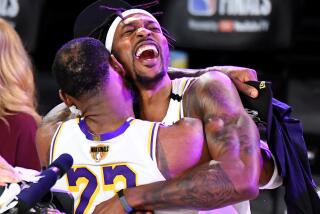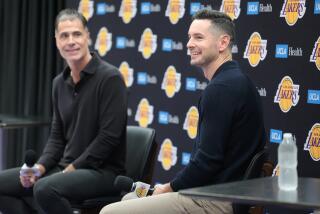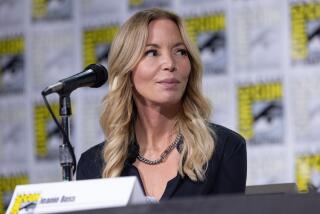âShowtimeâ ringmaster
When Jerry Buss bought the Lakers in 1979, he wanted to build a championship team. He also wanted to put on a show.
The new owner gave courtside seats to movie stars. He hired pretty women to dance during timeouts. He spent freely on big stars and encouraged a fast-paced, exuberant style of play.
As the Lakers sprinted to one NBA title after another, Buss cut an audacious figure in the stands, an aging playboy in bluejeans, often with a younger woman.
âI really tried to create a Laker image, a distinct identity,â he once said. âI think weâve been successful. I mean, the Lakers are pretty damn Hollywood.â
Buss, 80, died Monday of complications of cancer at Cedars-Sinai Medical Center in Los Angeles.
Lakers fans will remember Buss for bringing extraordinary success -- 10 championships in three-plus decades -- but equally important to his legacy was a sense of showmanship that transformed pro basketball from sport to spectacle.
âJerry Buss helped set the league on the course it is on today,â NBA Commissioner David Stern said. âRemember, he showed us it was about âShowtime,â the notion that an arena can become the focal point for not just basketball, but entertainment. He made it the place to see and be seen.â
His teams featured the likes of Kareem Abdul-Jabbar, Magic Johnson, Kobe Bryant, Shaquille OâNeal and Dwight Howard. He was also smart enough to hire Hall of Fame-caliber coaches in Pat Riley and Phil Jackson.
âIâve worked hard and been lucky,â Buss said. âWith the combination of the two, Iâve accomplished everything I ever set out to do.â
A Depression-era baby, Jerry Hatten Buss was born in Salt Lake City on Jan. 27, 1933, although some sources cite 1934 as his birth year. His parents, Lydus and Jessie Buss, divorced when he was an infant.
His mother struggled to make ends meet as a waitress in tiny Evanston, Wyo., and Buss remembered standing in food lines in the bitter cold. They moved to Southern California when he was 9, but within a few years she remarried and her second husband took the family back to Wyoming.
His stepfather, Cecil Brown, was, as Buss put it, âvery tight-fisted.â Brown made his living as a plumber and expected his children (one from a previous marriage, another son and a daughter with Jessie) to help.
This work included digging ditches in the cold. Buss preferred being a bellhop at a local hotel and running a mail-order stamp-collecting business that he started at age 13.
Leaving high school a year early, he worked on the railroad, pumping a hand-driven car up and down the line to make repairs. The job lasted just three months.
Until then, Buss had never much liked academics. But he returned to school and, with a science teacherâs encouragement, did well enough to earn a science scholarship to the University of Wyoming.
Before graduating with a bachelorâs degree in chemistry, when he was 19 he married a student named JoAnn Mueller and they would eventually have four children: John, Jim, Jeanie and Janie.
The couple moved to Southern California in 1953, when USC gave Buss a scholarship for graduate school. He earned a doctorate in physical chemistry in 1957. The degree brought him great pride -- Lakers employees always called him âDr. Buss.â
He was hired by Douglas Aircraft Co. in February 1958, part of a team that developed rocket fuel and other classified material. But the idea of a career in aerospace did not appeal to Buss. As the 1950s drew to a close, he and a Douglas colleague, Frank Mariani, decided to try their hand at real estate.
They scraped together a few thousand dollars and took out multiple mortgages to buy a 14-unit apartment house in West Los Angeles and, to save money, did all the repairs themselves. Once, fixing a damaged wall after work, Buss peeled off his T-shirt, stuffed it into the hole and plastered over it.
They soon bought a second building and stumbled onto some good fortune. The partners -- along with several relatives -- won $12,000 at the racetrack, then bought yet another building, soon discovering oil on the property and receiving lucrative royalty rights.
âEverybody just felt like God loves us,â Buss recalled in the book âWinninâ Times,â written by former Times sportswriters Scott Ostler and Steve Springer. âEverything we did just went the right way.â
Now millionaires, Buss and Mariani turned to another sort of venture. Gathering friends as investors, they bought into the fledgling World Team Tennis league in 1974. Buss purchased the Los Angeles Strings and Mariani bought the San Diego Friars. The Strings won a championship in 1978, but the league did not last much longer. Buss went looking for a bigger, better opportunity.
âI have enough money to own a major league team,â he said at the time. âAnd I intend to do so.â
Jack Kent Cooke, who had built the Forum in Inglewood to house his Lakers and Kings, was in the midst of an expensive divorce and wanted to cash out. He began negotiating with Buss.
The asking price was $33.5 million for the arena, $16 million for the Lakers, $8 million for the Kings and $10 million for a ranch. Buss suggested a real-estate swap to avoid capital gains taxes and wound up unloading the majority of his holdings. As part of the deal, he bought the Chrysler Building in New York City and traded it to Cooke.
Negotiations nearly fell through at the last minute when an investor dropped out, leaving Buss to scramble for more money, including a $1-million loan from Marianiâs friend Donald T. Sterling, who would later purchase the Clippers.
Once again, Buss was leveraged to the hilt, as he was at the start of his real estate career. Once again, he was taking a risk.
The NBA -- the âsport of the â70sâ -- had fallen by the wayside. Several teams stood on the brink of bankruptcy, CBS was broadcasting finals games on tape delay instead of live, and there were reports of rampant drug use among players.
But to Buss, the Lakers looked like a gem in the coal bin. Seven years removed from their last title, they had a dominant center in Abdul-Jabbar and were poised to select the effervescent Johnson out of Michigan State in the 1979 NBA draft.
Buss added something more to the mix: a vision for the future.
He did not pretend to know much about Xs and Oâs, so he hired Jack McKinney, a coach who favored running, to introduce an up-tempo brand of basketball.
Next came a live band to perform with the Laker Girls during timeouts.
Celebrities began showing up for games, encouraged by the management. The list of Hollywood regulars would grow to include Denzel Washington, Dyan Cannon, Leonardo DiCaprio and Penny Marshall. Jack Nicholson cemented his position as the No. 1 fan, seated courtside, close to the visiting teamâs bench so he could needle foes.
âJerry Buss is always thinking in terms of putting a show on,â said Lon Rosen, the former Lakers publicist who became Johnsonâs agent. âEverything the Lakers do, everything is planned.â
So there were always two sides to Buss. People closest to him saw an astute businessman, an owner who boosted revenues by raising the cost of premium seats while giving everyday fans a better deal in the upper sections of the arena.
âAt heart, heâs a mathematician,â said Bob Steiner, his longtime public relations manager. âHe always told me, âWork the numbers. No matter what common sense may tell you, work the numbers.â â
But much of the world saw him as a maverick, a rich man who acted like one of the guys.
âI saw him walking in with these jeans on,â Johnson recalled of their first meeting. âI said, âThis manâs got all this money?â â
This unpretentious style helped Buss, divorced and known as a playboy, forge close relationships with many of his players. After games, he transformed the Forumâs press lounge into a late-night party spot, entertaining athletes, reporters and young women as announcer Chick Hearn poured drinks at the bar.
Buss said: âJust because Iâm a public figure doesnât mean I donât get to live my life the way I want.â
Success came quickly. With former Lakers star Jerry West maturing into one of the most gifted general managers in the league, the team won an NBA championship in Bussâ first season.
âYou donât know how long Iâve waited for this moment,â Buss told his players in the locker room.
The good times lasted almost a decade as Johnson, Abdul-Jabbar and Michael Cooper guided the Lakers to five titles. But no team can stay on top forever, and the franchise struggled through much of the 1990s.
Buss stopped hanging around so much, and the front office became more bureaucratic. West was obliged to train and consult with the ownerâs son Jim, who was given the title of assistant general manager. It took some bold moves to turn things around.
West tore the roster apart in the summer of 1996, trading center Vlade Divac and reducing the payroll enough to make a run at OâNeal, who was nearing the end of his contract with the Orlando Magic.
As negotiations stalled, West wondered if the team should settle for Plan B, signing another center, Dikembe Mutombo, and a big power forward in Dale Davis.
Buss insisted that his general manager keep pursuing OâNeal, so West traded away two more players, creating enough salary cap room to give OâNeal the $118-million offer he demanded.
âWe knew we were out on a limb,â Buss said. âWe were going to either be very sorry or very ecstatic.â
The Divac trade allowed the Lakers to add the precocious Bryant out of high school, but when the team fell short of winning it all the next three seasons, Buss had to roll the dice one more time.
Going against a previous dictum to spend conservatively on coaches, he paid $30 million over five seasons to hire Jackson in 1999.
âIt is a lot of money for a coach,â Buss said. âWhen youâre used to paying $1 million and perhaps $2 million, to jump to perhaps three times that amount, takes a while.â
The franchise moved into Staples Center, a downtown location with state-of-the-art accommodations and -- just as important -- 160 revenue-producing luxury suites. Buss would realize pre-tax profits estimated at more than $50 million over the next few years.
Jacksonâs arrival marked the final step in the greatest rebuilding project of the salary cap era.
The Lakers celebrated a âthree-peatâ with three consecutive championships starting in 1999-2000, and once again Buss drifted away from day-to-day operations, only to be drawn back in.
When OâNeal agitated for a long-term contract in 2003, the owner balked. The team flamed out in the 2004 NBA Finals against the Detroit Pistons and traded OâNeal to the Miami Heat. Then Jackson walked away, saying he wanted to âpause and reflect.â
A few more disappointing seasons made Bryant antsy, and he demanded a trade. But Buss stood firm, intent on keeping the superstar guard as the focus of his team.
Having already acquired Lamar Odom in the OâNeal trade, the Lakers traded to get Spanish forward Pau Gasol from the Memphis Grizzlies in February 2008. âWhen we got him, that was a dream come true,â Buss said. âHeâs a different kind of player in a lot of ways.â
The Lakers lost to the archrival Boston Celtics in the NBA Finals that spring but rebounded to defeat Orlando for the 2008-09 title. The next season, they earned revenge against Boston for another championship.
It was their 10th and final title under Buss, and a particularly satisfying victory for the owner, who said: âOne of the biggest reasons I bought the Lakers was to beat the Celtics.â
That year, 2010, he was inducted into the basketball Hall of Fame. Buss, who also owned the Sparks of the WNBA and the Lazers of the Major Indoor Soccer League, eventually sold all of his sports teams except the Lakers. This year, Forbes valued the team at $1 billion.
The final months of Bussâ life were not a particularly happy time for the Lakers.
Last summer, the team made headlines with another pair of blockbuster moves, paying tens of millions to acquire free agents Howard and Steve Nash.
With Bussâ health failing, there was much speculation about who ran the operation, him or his son Jim. The questions grew louder as the team stumbled out of the blocks, firing Coach Mike Brown and bypassing Jackson to hire Mike DâAntoni.
Despite their Hall of Fame roster, the Lakers suffered a losing record through the first months of the season and fans grumbled. But those struggles cannot overshadow what Buss had done for the franchise.
Bussâ survivors include his children from his marriage to JoAnn Mueller: son Jim, executive vice president of player personnel for the Lakers; daughter Jeanie, the teamâs executive vice president of business operations; another son, John, the Lakersâ executive vice president of strategic development; and daughter Janie Drexel, the Lakersâ director of charitable services. He is also survived by two children from his relationship with Karen Demel: son Joey, an executive with the Los Angeles D-Fenders, the Lakersâ minor-league affiliate; and son Jesse, the Lakersâ director of scouting; and eight grandchildren. His half sister Susan Hall, half brother Mickey Brown, and stepbrother Jim Brown also survive him.
--
Times staff writer Mike Bresnahan and former Times staff writer Mark Heisler contributed to this report.
--
BEGIN TEXT OF INFOBOX
Jan. 27, 1933: Born in Salt Lake City to Lydus and Jessie Buss. 1952: Marries JoAnn Mueller; the couple later have four children. 1953: Buss earns a bachelorâs in chemistry at the University of Wyoming. 1957: Earns a doctorate in physical chemistry at USC. 1959: Saves $1,000, pools it with friends and buys an apartment building in West L.A. 1962: Partners with friend Frank Mariani. Mariani-Buss Associates invests in residential properties, apartments, hotels and office buildings. 1968: Separates from wife; they later divorce. 1974: Buys L.A. Strings, World Team Tennis; league folds in 1978. 1979: Buss and his partners purchase the Lakers, the Forum in Inglewood, the NHLâs Kings and a ranch in Kern County from Jack Kent Cooke. 1980: The Lakers, with rookie Magic Johnson and veteran Kareem Abdul-Jabbar, beat Philadelphia for the Lakersâ first championship under Buss. 1981: Buss signs Johnson to a 25-year, $25-million contract, then the richest in sports history. 1985: Buss and Bill Daniels start cable sports network Prime Ticket; company sold in 1994 for an estimated $230 million. 1988: Buss sells remaining stake in Kings. Lakers, with Johnson and Abdul-Jabbar, win fifth title in the âShowtimeâ era. 1991: Magic Johnson retires after announcing he has HIV. 1996: In July, Lakers General Manager Jerry West signs Shaquille OâNeal and trades for recently drafted high schooler Kobe Bryant. 1999: Buss hires Phil Jackson as coach; team moves into Staples Center. 2000-02: Lakers win three straight titles with Jackson, OâNeal and Bryant. 2004: Lakers lose in the NBA Finals. Jackson leaves and OâNeal is traded to Miami. Lakers hire Rudy Tomjanovich as coach. 2005: Tomjanovich resigns in the middle of 2004-05 season; Lakers miss playoffs for second time in the Buss era. Buss rehires Jackson as coach. 2007: After consecutive years of first-round playoff losses, Bryant demands to be traded. Buss considers trading his star but doesnât. 2008: Lakers trade for Pau Gasol; team reaches Finals but loses to Boston. 2009: Lakers beat Orlando for the NBA title. 2010: Lakers defeat Celtics in seven games for title No. 10 in the Buss era. 2011: Jackson retires after Lakers are swept in second round of playoffs. Lakers hire Mike Brown as coach. 2012: In November, Lakers fire Brown; Mike DâAntoni is hired as coach. 2013: Buss dies Feb. 18 of complications from cancer at Cedars-Sinai Medical Center, according to his spokesman.
More to Read
All things Lakers, all the time.
Get all the Lakers news you need in Dan Woike's weekly newsletter.
You may occasionally receive promotional content from the Los Angeles Times.








